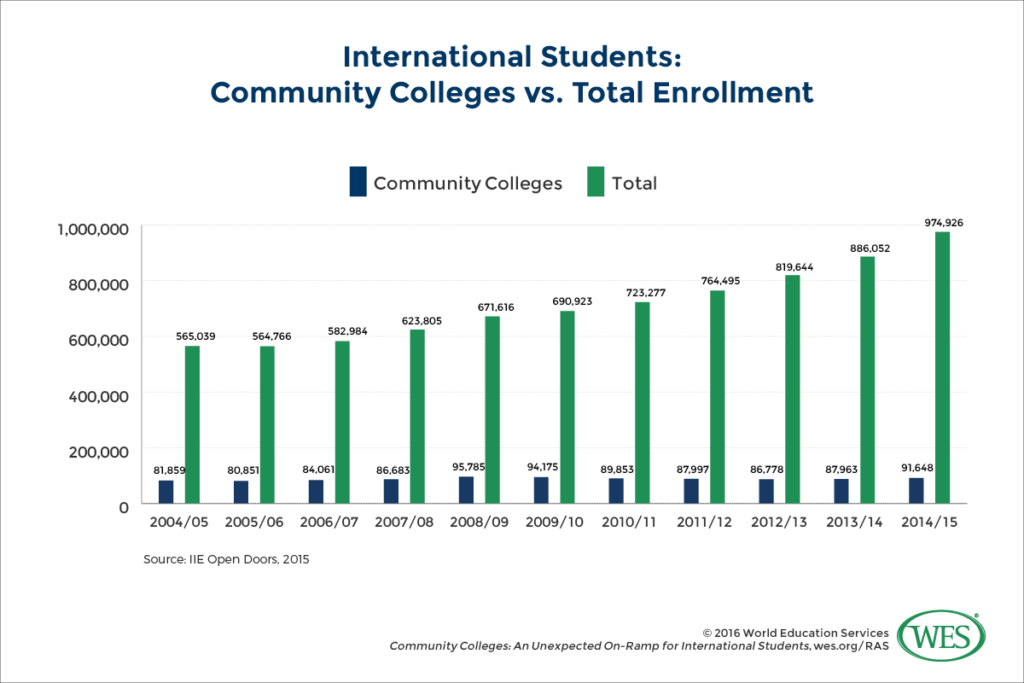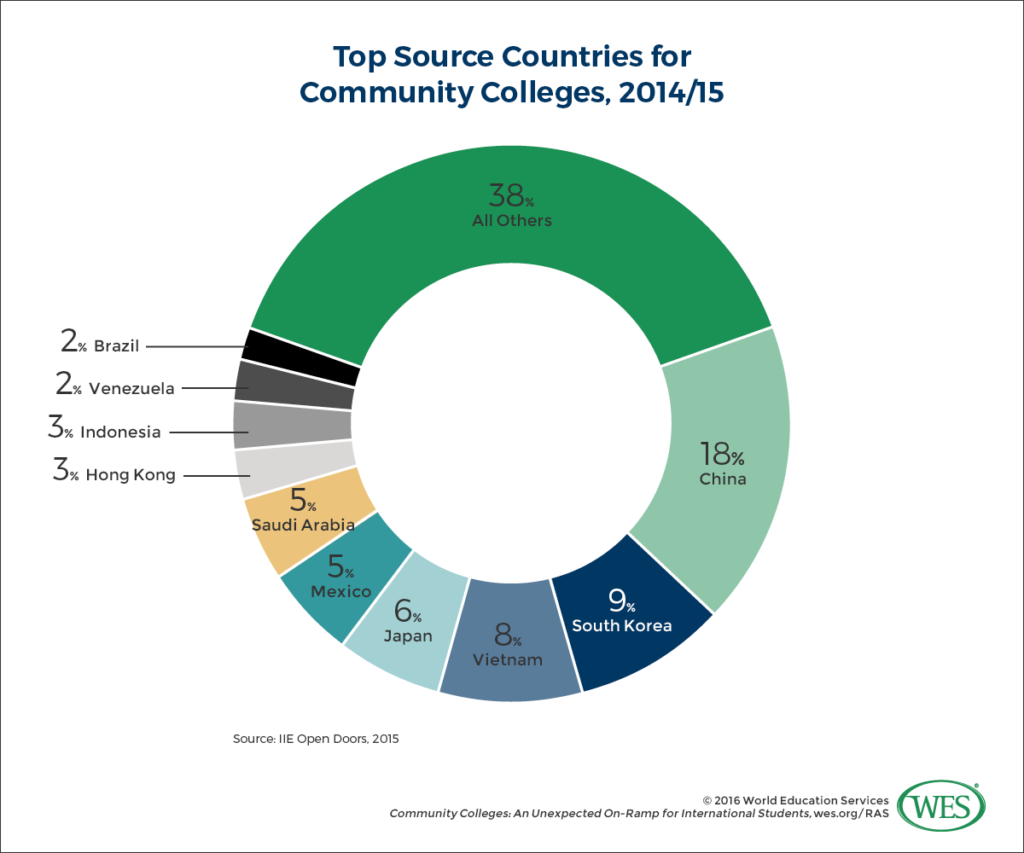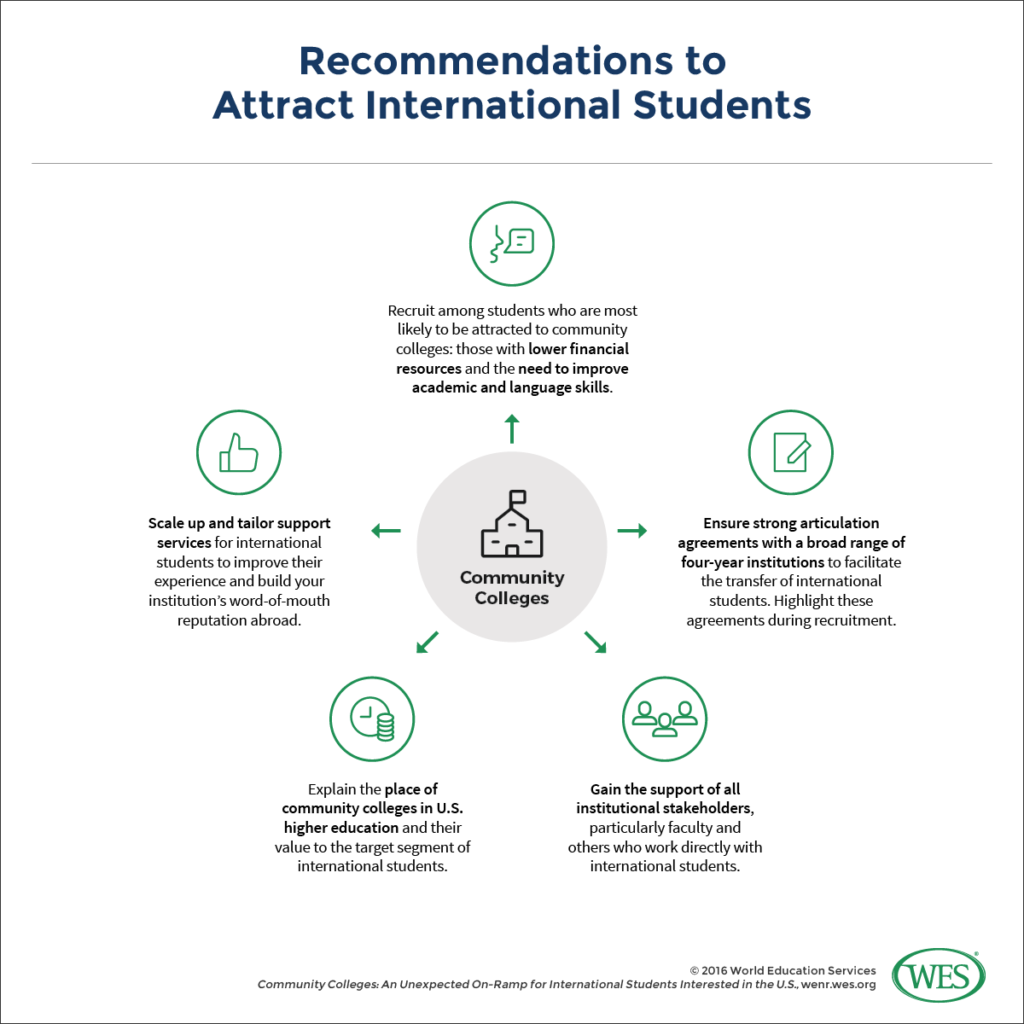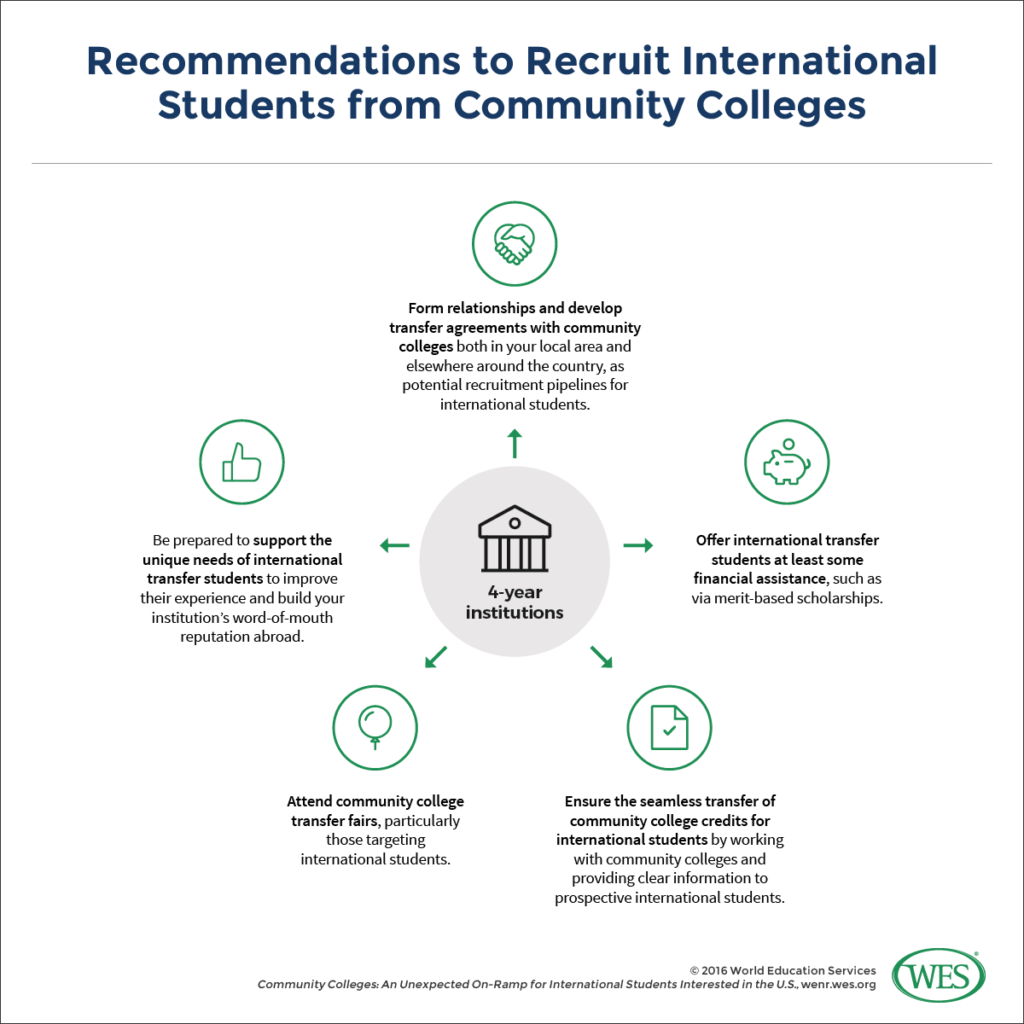Community Colleges: An Unexpected On-Ramp for International Students
Bryce K. Loo, Research Associate, WES
Community colleges are often overlooked in discussions about international student mobility and recruitment in the United States. Yet these institutions collectively host more than nine percent of all international students in the U.S. And there is potential for greater growth, especially among key student populations.
The potential to increase international enrollments at community colleges, particularly among students from top source countries such as China, South Korea, and Vietnam, is real. According to the Institute of International Education’s (IIE) Open Doors Report for 2014/15, international student enrollments in community colleges peaked in 2008/09 at over 95,000 and then declined until 2012/13. The numbers have risen steadily since, reaching 91,000 in the 2014/2015 academic year. International students now account for roughly 9.4 percent of all international enrollments in the United States. However, only 1.3 percent of total community college enrollments are international, a percentage that has held steady for many years.
The key is to target the right students. Those who are well-financed and who have well-honed academic skills will likely go directly to four-year institutions. Other potential recruits, however, especially those from particular countries and regions, don’t fit this profile. Many lack the financial resources to pay full fees at a four-year institution, but still aspire to an international education, especially in the U.S. Others need to improve key academic skills, often including language skills before obtaining admission to a bachelor’s level program. Both of these students groups may well find a good fit on community college campuses.
To attract these students, community colleges must do a number of things, including explaining the community college model, and making the case that community colleges can act as a stepping stone that will help under-resourced or under-skilled international students achieve their ultimate academic goals (i.e., a bachelor’s degree or higher). Four-year institutions seeking to build their international enrollments can also take a number of steps to foster relationships with community colleges, in order to take advantage of a new, well-qualified source of prospective international students who understand the American education system and have mastered the skills they need to succeed at more advanced levels.
NOTE: The WES international student segmentation framework, launched in 2012, divides international students into four segments based on their academic preparedness and financial resources. “Strugglers” are those who lack significant financial resources and who have not yet mastered the academic skills (for instance, English language skills) required to gain admission to four-year institutions. The framework, which looks at distribution of students across the segments based on county and region of origin among other factors, provides a useful tool for institutions seeking to identify “best fit” students, broaden efforts to reach new segments; or provide more effective supports for current students.
Where Do Most International Students at Community Colleges Come From? And Where Do They Go?
China, South Korea, and Vietnam are the top three source countries for international students who enroll at community colleges. Roughly 41 percent of all Vietnamese students in the U.S. were, as of IIE’s 2014/2015 estimates, enrolled at community colleges, making the country a significant target for recruiters at two-year institutions. (By contrast, only five percent of Chinese students enrolled at U.S. institutions are attending community colleges – likely in part because they tend to be reputation-conscious and often can afford a four-year institution out of pocket.) Japan, Mexico, Hong Kong, and Indonesia each also send relatively high percentages of their U.S.-bound students to community colleges.
International students from these regions end up at community colleges nationwide. The Houston Community College System, which has 13 campuses and some 55,000 students, is the fourth largest community college system in the United States. It is also the largest host of international students, with nearly 5,500 enrollments from around the world. Most of the other top hosting institutions are, perhaps unsurprisingly, in major metro areas – Houston, Los Angeles, the San Francisco Bay Area, Seattle, and Washington, DC, among others.
Vietnam: A Hot Recruiting Market for Community Colleges
Vietnam has proven to be a strong sending market for community colleges in recent years. More than half of Vietnamese students in the U.S. start at a community college. In 2014/15, 18,722 Vietnamese students in the U.S. constituted 8.4 percent of all international enrollments at community colleges. Why are Vietnamese students so prevalent in community colleges? Similar to Chinese families, Vietnamese parents put a high premium on education, and overseas education is highly desired. The U.S. tends to be the first-choice destination among a majority of outbound Vietnamese students, and those lacking financial resources or college readiness may opt for to start in a community college, even if they intend to continue their studies at the bachelor’s level or higher. Of particular note on this front is the fact that most Vietnamese students are self-funded and have relatively small budgets, particularly compared to their Chinese peers. Migration patterns likely also play a role, with diaspora communities helping facilitate entrance of Vietnamese relatives and friends.
Increased International Interest in Community Colleges: Who Benefits?
The implications of growth in this part of the higher education sector are largely positive for both students and institutions. Key beneficiaries include:
1. Community colleges and local students: International students offer needed revenue streams to community colleges at a time when public funding is diminishing. They also help to expose the larger student population to their international perspectives, and bring valuable global experiences and viewpoints to institutions that are, by design, local in nature.
2. International students who struggle to find a good fit on 4-year campuses, whether because of finances or needed English-Language skills. Community colleges represent an educational on-ramp for students who might otherwise be shut out of the U.S. higher education system.
Community colleges lessen a number of these barriers. For one thing, they have open admissions. For another, they are typically far more affordable for these students than four-year institutions. For example, at Santa Monica College, which hosts the second largest number of international students in the U.S.1, international students will pay roughly $8,143 a year for full-time coursework (24 units) during the 2016/17 school year, not including the mandatory health insurance coverage2. This is much less expensive than nearby California State University Long Beach (CSULB), where international students (and other non-California residents) would pay around $15,388 for the same number of units. And, it is significantly less expensive than the University of California, Los Angeles (UCLA), where they would pay about $42,076 a year.
Moreover, at least some community colleges have an explicit focus on helping students, whether foreign or domestic, transition to four-year institutions. They can thus be a perfect pathway for international students who don’t quite have what it takes, whether financially or academically, to attend a four-year institution.
3. Four-year institutions: This pathway model benefits four-year institutions seeking to boost international enrollments as well. Community colleges can serve as cost-effective recruitment pipelines for four-year institutions, without the expense or uncertainties of international travel. Some community colleges also host transfer fairs for international students, inviting recruiters from all around North America to recruit students. In the Seattle area, local community colleges have even come together and hosted joint transfer fairs for international students. Many community colleges that enroll significant numbers of international students also have articulation agreements with four-year institutions, giving both domestic and international students the ability to transfer with relative ease. Green River College, a community college located in Auburn, Washington, just outside of Seattle, has agreements with 30 four-year colleges and universities around the country and abroad, stipulating that students who meet certain requirements are eligible for conditional admission.
The Flip-Side: Challenges Posed by Increased International Enrollments at Community Colleges
For all the promised benefits that international enrollments promise, both institutions and students should be prepared to address certain barriers. These span awareness, the visa process, student services and support, and community and faculty engagement.
1. The Awareness Issue Among International Students: What’s a Community College? One substantial challenge that community colleges face on the international recruitment market extends beyond reputation. International students from many countries are altogether unfamiliar with the concept of community colleges, either as a stepping stone to a four-year institution or as a terminal degree option; no equivalent exists in their own higher education systems. That said, many countries – for instance, Indonesia, Qatar, and India – have begun to explore and implement (with varying degrees of success) the community college model. In a handful of countries such as Vietnam, long-term recruitment efforts by community colleges seems to have contributed to growing interest and awareness of the model.
2. The Awareness Issue Among Consular Staff: Can Community Colleges be an International Education Destination? Anecdotally, some international students trying to enroll in community college still face unexpected visa denials, an issue raised by Green River College Vice President Ross Jennings at last spring’s national NAFSA conference in Denver. The problem has been around since at least 2011, when some international students reported difficulties securing F-1 visas for entrance into U.S. community colleges. Denials then and now may, say observers, stem from a lack of understanding among staff at U.S. embassies and consulates about how community colleges can serve international students.
While there is little that an institution can do to directly affect the visa application process in favor of the applicant, many community colleges use their websites to transparently explain to students how to effectively prepare for a visa interview. For example, students should be able to explain how community college fits into their planned educational trajectories.
Some institutions have also been known to write letters to consular officers on behalf of students whose visa applications have been denied. In such letters, institutional representatives typically explain the relationship between the student and the college, and address issues such as support systems for students and benefits to the local economy. In general, community colleges that recruit international students should be prepared to support international students through the visa application process as best as they can.
3. The Support Challenge: Language, Housing Needs, Acculturation – Community colleges have open admissions policies. This means that many, if not most, international students who are admitted will likely need substantial academic and linguistic support to succeed on campus. Faculty and support staff should also be trained to support international students in a culturally sensitive manner.
International students will also likely need other forms of support as well. For example, international students may need help finding and securing local housing – typically not a service offered by community that serve local commuter populations. International students may also need help acculturating to American academic norms. Some community colleges have well-established practices for helping students to adjust. For instance, the Chronicle of Higher Education’s Karin Fischer noted in 2011 that, “[f]or more than a decade, Riverside Community College [in Riverside, California] has required all international students to take two for-credit courses on the American classroom and on college success.” However, such practices are rare.
4. The Mission-Alignment Challenge: Community Engagement – Perhaps most crucially, community colleges align international recruitment efforts with their missions of serving their local communities3 and must actively strive to engage members of the on-campus community. Gaining the support of all campus stakeholders is key. In the case of Green River College, where the student body is now almost 25 percent international, the large-scale recruitment of international students has caused concern among faculty. While generally supportive of international students themselves, the faculty has clashed with administration over recruitment of international students as a method of generating revenue, questioning the potential for negative impact on access and support services for local students. Efforts to address the challenges include a task force on international student teaching and learning, and an international education committee, which works with both the international program office and the schools Instructional Council.
Recommendations
Not all international students will be interested in community colleges. Those with adequate financial resources and academic skills will likely go directly to four-year institutions. However, there is a significant cohort of students seeking either a lower cost option or a pathway into four year institutions. The key for community colleges is to target the right students, mostly those who have low financial resources and who need to improve their academic skills, often including language skills, for entrance into a bachelor’s level program.
Community colleges must make the case to these students that they can assist them in working towards their ultimate academic goals (i.e., a bachelor’s degree or higher). Having articulation agreements with a variety of four-year institutions, both locally and in other locales (including other states) – to provide a variety of choices to students – and clear transfer processes is key. Four-year institutions seeking to build their international enrollments can also take a number of steps to foster relationships with community colleges.
Tips for Community Colleges
- Recruit among students who are most likely to be attracted to community colleges: those with lower financial resources and the need to improve academic and language skills.
- Explain the place of community colleges in U.S. higher education and their value to the target segment of international students.
- Ensure strong articulation agreements with a broad range of four-year institutions, both in the local area (or nearby) and elsewhere, to facilitate the relatively easy transfer of international students. Highlight these agreements during recruitment.
- Gain the support of all institutional stakeholders, particularly those who will work directly with international students, and make the case for recruiting international students.
- Scale up support services for international students commensurate with recruitment.
- Understand where international students may have different or additional needs than domestic/local students, such as with housing assistance, and provide matching services.
Tips for Four-Year Institutions
- Form relationships and develop transfer agreements with community colleges both in your local area and elsewhere around the country, as potential recruitment pipelines for international students.
- Attend community college transfer fairs, particularly those targeting international students, and work with community colleges on other forms of recruitment of international transfer students.
- Ensure the seamless transfer of community college credits for international students as much as possible by working with community colleges and providing clear information to prospective international transfer students.
- Offer at least some financial assistance, such as via merit-based scholarships, where possible.
- Be prepared to support the unique needs of international transfer students, which are often different from those of domestic transfer students.
1. Santa Monica College may likely host the largest number of international students as a stand-alone campus, as the first on the list is the entire community college system in Houston, according to IIE’s Open Doors Report for 2014/15.
2. Like their four-year counterparts, most community colleges charge international students out-of-state tuition and sometimes additional international student fees. For example, at Santa Monica College, California residents pay about $1,661 a year in tuition and fees, compared with the over $8,000 that non-California residents, including international students, pay for full-time coursework. However, of all options available to international students, community colleges still remain the cheapest on average.
3. For a good discussion of the historic mission of community colleges, see Troyer, D. K. (2015, January). The mission of the community college: relevant in 2015? Perspective: Community College Leadership for the 21st Century. Retrieved from https://www.ferris.edu/HTMLS/administration/academicaffairs/extendedinternational/ccleadership/alliance/documents/Perspectives_2015-01January/Perspectives-January2015.pdf.



